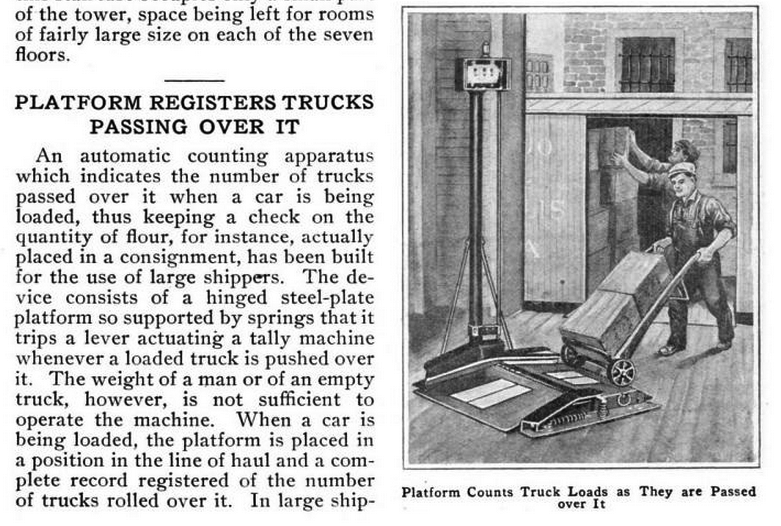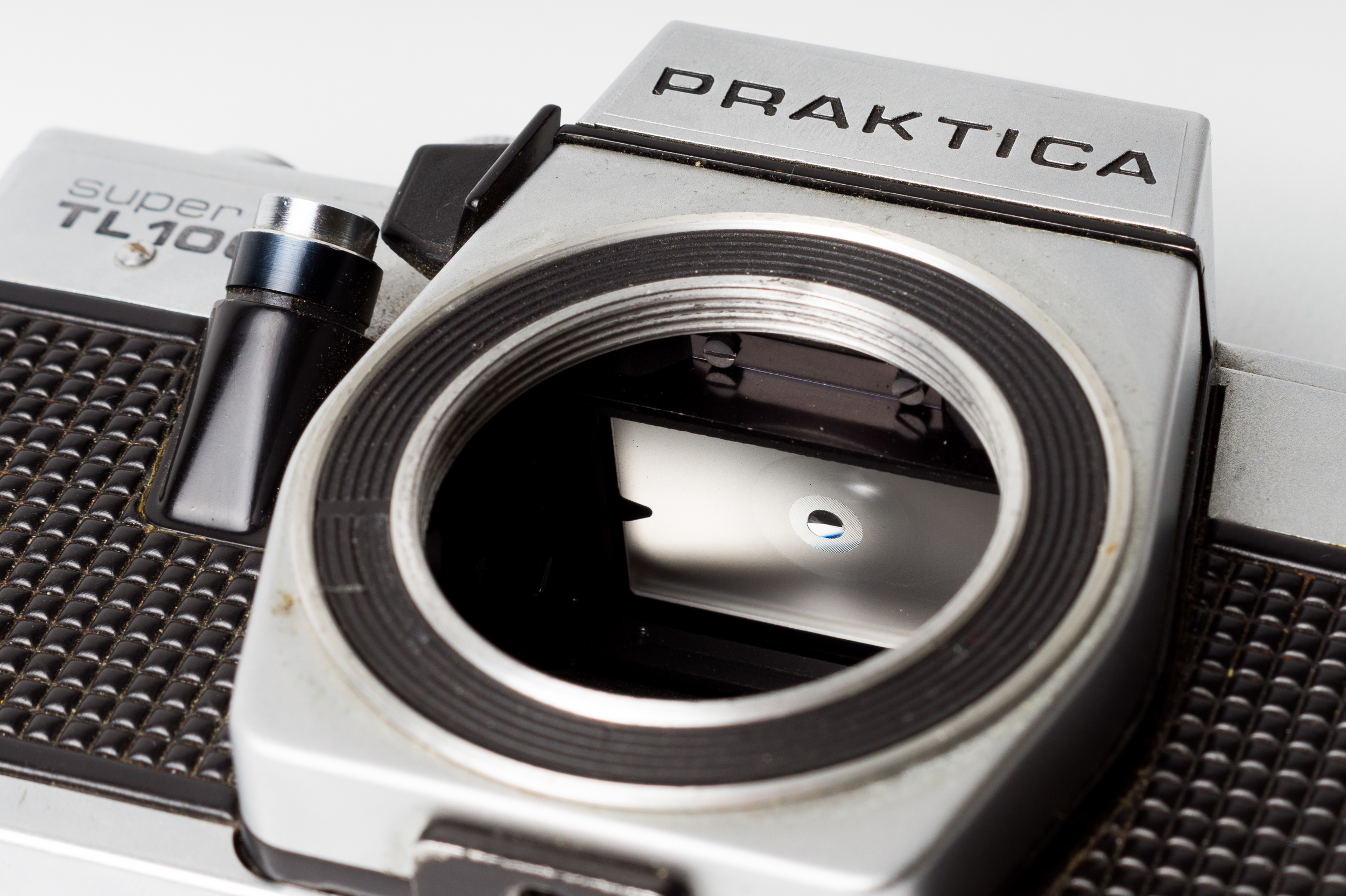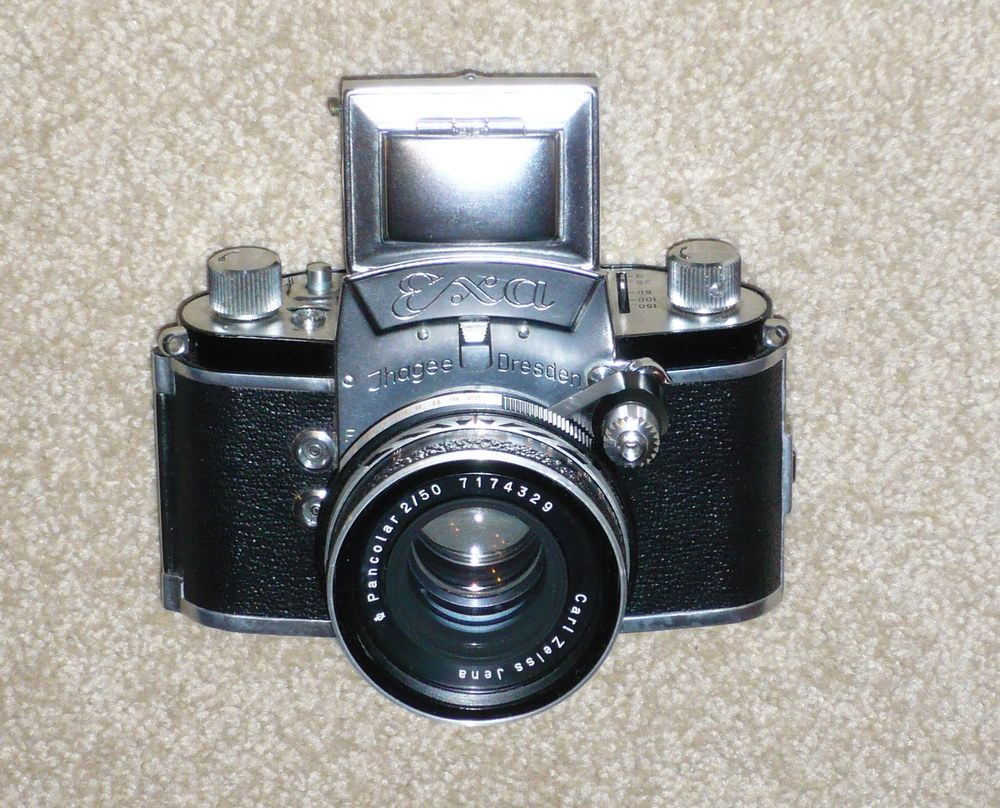|
Manual Focus
In the field of photography, a manual focus camera is one in which the user has to adjust the focus of the lens by hand. Before the advent of autofocus, all cameras had manually adjusted focusing; thus, the term is a retronym. The focus itself may be adjusted in a variety of ways. Larger view cameras and the like slide the lens closer or further from the film plane on rails; on smaller cameras, a focus ring on the lens is often rotated to move the lens elements by means of a helical screw. Other systems include levers on the lens or on the camera body. There are a number of ways in which focus may be determined. Simplest is using a distance scale and measuring or estimating distance to the subject. Other methods include the rangefinder, which uses triangulation to determine the distance. On other cameras, the photographer examines the focus directly by means of a focusing screen. On the view camera, this ground glass is placed where the film will ultimately go, and is repl ... [...More Info...] [...Related Items...] OR: [Wikipedia] [Google] [Baidu] |
Photography
Photography is the art, application, and practice of creating durable images by recording light, either electronically by means of an image sensor, or chemically by means of a light-sensitive material such as photographic film. It is employed in many fields of science, manufacturing (e.g., photolithography), and business, as well as its more direct uses for art, film and video production, recreational purposes, hobby, and mass communication. Typically, a lens is used to focus the light reflected or emitted from objects into a real image on the light-sensitive surface inside a camera during a timed exposure. With an electronic image sensor, this produces an electrical charge at each pixel, which is electronically processed and stored in a digital image file for subsequent display or processing. The result with photographic emulsion is an invisible latent image, which is later chemically "developed" into a visible image, either negative or positive, depending on the purp ... [...More Info...] [...Related Items...] OR: [Wikipedia] [Google] [Baidu] |
Camera
A camera is an Optics, optical instrument that can capture an image. Most cameras can capture 2D images, with some more advanced models being able to capture 3D images. At a basic level, most cameras consist of sealed boxes (the camera body), with a small hole (the aperture) that allows light to pass through in order to capture an image on a light-sensitive surface (usually a Image sensor, digital sensor or photographic film). Cameras have various mechanisms to control how the light falls onto the light-sensitive surface. Lenses focus the light entering the camera, and the aperture can be narrowed or widened. A Shutter (photography), shutter mechanism determines the amount of time the photosensitive surface is exposed to the light. The still image camera is the main instrument in the art of photography. Captured images may be reproduced later as part of the process of photography, digital imaging, or photographic printing. Similar artistic fields in the moving-image camera dom ... [...More Info...] [...Related Items...] OR: [Wikipedia] [Google] [Baidu] |
Focus (optics)
In geometrical optics, a focus, also called an image point, is a point where light rays originating from a point on the object converge. Although the focus is conceptually a point, physically the focus has a spatial extent, called the blur circle. This non-ideal focusing may be caused by aberrations of the imaging optics. In the absence of significant aberrations, the smallest possible blur circle is the Airy disc, which is caused by diffraction from the optical system's aperture. Aberrations tend to worsen as the aperture diameter increases, while the Airy circle is smallest for large apertures. An image, or image point or region, is in focus if light from object points is converged almost as much as possible in the image, and out of focus if light is not well converged. The border between these is sometimes defined using a "circle of confusion" criterion. A principal focus or focal point is a special focus: * For a lens, or a spherical or parabolic mirror, it is a point ... [...More Info...] [...Related Items...] OR: [Wikipedia] [Google] [Baidu] |
Photographic Lens
A camera lens (also known as photographic lens or photographic objective) is an optical lens or assembly of lenses used in conjunction with a camera body and mechanism to make images of objects either on photographic film or on other media capable of storing an image chemically or electronically. There is no major difference in principle between a lens used for a still camera, a video camera, a telescope, a microscope, or other apparatus, but the details of design and construction are different. A lens might be permanently fixed to a camera, or it might be interchangeable with lenses of different focal lengths, apertures, and other properties. While in principle a simple convex lens will suffice, in practice a compound lens made up of a number of optical lens elements is required to correct (as much as possible) the many optical aberrations that arise. Some aberrations will be present in any lens system. It is the job of the lens designer to balance these and produce a desi ... [...More Info...] [...Related Items...] OR: [Wikipedia] [Google] [Baidu] |
Autofocus
An autofocus (or AF) optical system uses a sensor, a control system and a motor to focus on an automatically or manually selected point or area. An electronic rangefinder has a display instead of the motor; the adjustment of the optical system has to be done manually until indication. Autofocus methods are distinguished as active, passive or hybrid types. Autofocus systems rely on one or more sensors to determine correct focus. Some AF systems rely on a single sensor, while others use an array of sensors. Most modern SLR cameras use through-the-lens optical sensors, with a separate sensor array providing light metering, although the latter can be programmed to prioritize its metering to the same area as one or more of the AF sensors. Through-the-lens optical autofocusing is usually speedier and more precise than manual focus with an ordinary viewfinder, although more precise manual focus can be achieved with special accessories such as focusing magnifiers. Autofocus accuracy ... [...More Info...] [...Related Items...] OR: [Wikipedia] [Google] [Baidu] |
Retronym
A retronym is a newer name for an existing thing that helps differentiate the original form/version from a more recent one. It is thus a word or phrase created to avoid confusion between older and newer types, whereas previously (before there were more than one type) no clarification was required. Advances in technology are often responsible for the coinage of retronyms. For example, the term "acoustic guitar" was coined with the advent of electric guitars; analog watches were renamed to distinguish them from digital watches once the latter were invented; and "push bike" was created to distinguish from motorbikes and motorized bicycles; finally "feature phones" were also coined behind smartphones. Etymology The term ''retronym'', a neologism composed of the classical compound, combining forms '' retro-'' (from Latin ''retro'', "before") + '' -nym'' (from Greek '' ónoma'', "name"), was coined by Frank Mankiewicz in 1980 and popularized by William Safire in ''The New York Time ... [...More Info...] [...Related Items...] OR: [Wikipedia] [Google] [Baidu] |
View Camera
A view camera is a large-format camera in which the lens forms an inverted image on a ground-glass screen directly at the film plane. The image is viewed and then the glass screen is replaced with the film, and thus the film is exposed to exactly the same image as was seen on the screen. This type of camera was first developed in the era of the daguerreotypeStroebel, L. D. (1986). ''View Camera Technique'', 5th ed., p. 212. Boston: Focal Press. (1840s–1850s) and is still in use today, some with various drive mechanisms for movements (rather than loosen-move-tighten), more scale markings, and/or more spirit levels. It comprises a flexible bellows that forms a light-tight seal between two adjustable ''standards'', one of which holds a lens, and the other a ground glass or a photographic film holder or a digital back.Stroebel (1986). p. 2. There are three general types, the rail camera, the field camera, and others that don't fit into either category. The bellows is a flexi ... [...More Info...] [...Related Items...] OR: [Wikipedia] [Google] [Baidu] |
Film Plane
A film plane is the surface of an image recording device such as a camera, upon which the lens creates the focused image. In cameras from different manufacturers, the film plane varies in distance from the lens. Thus each lens used has to be chosen carefully to assure that the image is focused on the exact place where the individual frame of film or digital sensor is positioned during exposure. It is sometimes marked on a camera body with the 'Φ' symbol where the vertical bar represents the exact location. Movie cameras often also have small focus hooks where the focus puller can attach one side of a tape measure to quickly gauge the distance to objects that he intends to bring into focus. The measurement is taken from the film plane to the subject. Due to Petzval field curvature, the film plane upon which a lens focuses may not be a literal plane. Cameras may bend the film stock or even plate stock slightly to compensate, improving the area of critical focus and sharpness. Nev ... [...More Info...] [...Related Items...] OR: [Wikipedia] [Google] [Baidu] |
Rangefinder
A rangefinder (also rangefinding telemeter, depending on the context) is a device used to measure distances to remote objects. Originally optical devices used in surveying, they soon found applications in other fields, such as photography and in the military. They were specially useful for finding the range of a target, such as in naval gunnery and anti-aircraft artillery. The word ''telemeter'' is derived . Designs The first rangefinder telemeter was invented by James Watt in 1769 and put to use in 1771 in surveying canals. Watt called his instrument a micrometer, a term now used with a different meaning in engineering (the micrometer screw gauge). It consisted of two parallel hairs in the focal plane of a telescope eyepiece crossing an upright hair. At the point to be measured, two sliding targets on a surveyor's rod were adjusted to align with the hairs in the telescope. The distance to the rod could then be determined from the distance between the targets on the ro ... [...More Info...] [...Related Items...] OR: [Wikipedia] [Google] [Baidu] |
Focusing Screen
A focusing screen is a flat translucent material, either a ground glass or Fresnel lens, found in a system camera that allows the user of the camera to preview the framed image in a viewfinder. Often, focusing screens are available in variants with different etched markings for various purposes. For instance, "overall matte" focusing screens with no etchings are a popular choice for astrophotography and other low-light situations. Overview The history of the focusing screen is almost as long as the history of the camera. Some primitive cameras consisted of a box with a board holding the lens in the front and a focusing screen in the back that was replaced by the imaging medium (plate, film holder) before taking the picture. The most common type of focusing screen in non-autofocus 35 mm SLR cameras is the split screen and microprism ring variation that aids focusing and became standard in the 1980s. The microprism ring breaks up the image unless the lens setting is in focu ... [...More Info...] [...Related Items...] OR: [Wikipedia] [Google] [Baidu] |
Twin Lens Reflex
A twin-lens reflex camera (TLR) is a type of camera with two objective lenses of the same focal length. One of the lenses is the photographic objective or "taking lens" (the lens that takes the picture), while the other is used for the viewfinder system, which is usually viewed from above at waist level. In addition to the objective, the viewfinder consists of a 45-degree mirror (the reason for the word ''reflex'' in the name), a matte focusing screen at the top of the camera, and a pop-up hood surrounding it. The two objectives are connected, so that the focus shown on the focusing screen will be exactly the same as on the film. However, many inexpensive 'pseudo' TLRs are fixed-focus models. Most TLRs use leaf shutters with shutter speeds up to 1/500 of a second with a bulb setting. For practical purposes, all TLRs are film cameras, most often using 120 film, although there are many examples which used 620 film, 127 film, and 35 mm film. Few general-purpose digital TLR ca ... [...More Info...] [...Related Items...] OR: [Wikipedia] [Google] [Baidu] |
Single Lens Reflex
A single-lens reflex camera (SLR) is a camera that typically uses a mirror and prism system (hence "reflex" from the mirror's reflection) that permits the photographer to view through the lens and see exactly what will be captured. With twin lens reflex and rangefinder cameras, the viewed image could be significantly different from the final image. When the shutter button is pressed on most SLRs, the mirror flips out of the light path, allowing light to pass through to the light receptor and the image to be captured. History File:Hasselblad 1600F.jpg, Medium format SLR by Hasselblad (Model 1600F), Sweden File:Zenza BRONICA S2 with ZENZANON 100mm F2.8.JPG, Medium format SLR by Bronica (Model S2), Japan. Bronica's later model—the Bronica EC—was the first medium format SLR camera to use an electrically operated focal-plane shutter File:Asahiflex600.jpg, The 1952 (Pentax) Asahiflex, Japan's first single-lens reflex camera. File:Contaflex BW 2.JPG, The Contaflex III a single- ... [...More Info...] [...Related Items...] OR: [Wikipedia] [Google] [Baidu] |






.jpg)
